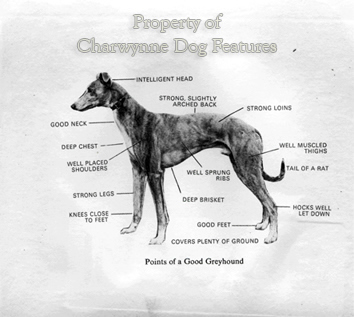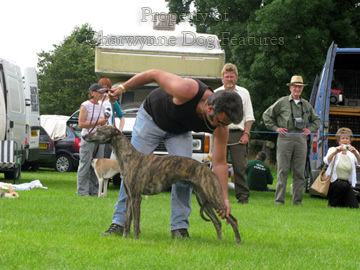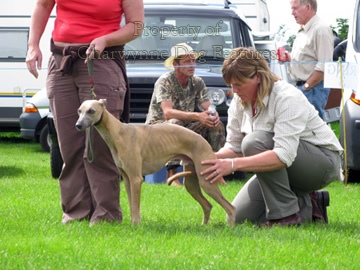927 ASSESSING THE LURCHER
ASSESSING THE LURCHER
by David Hancock

.jpg) At lurcher shows I often study how the judge goes about his business. But at some shows I do get the impression that the judge is actually 'winging it' - and that insults the entry and their owners. Each and every lurcher judge must have knowledge. Every judge must surely start by accepting the fundamental fact that any dog that hunts using its speed must have the physique to do so. A lurcher judge must look for, at the front, a long strong muzzle with powerful jaws and a level bite. How else can it catch and retrieve its quarry? The nose should be good-sized with well-opened nostrils, for, despite some old-fashioned theories, lurchers hunt using scent as well as sight. A long muzzle permits better scenting. For any lurcher to succeed, its eyes should be fairly prominent and be set slightly oblique, to the side of the head. The neck should be long but symmetrically so, muscular and firm. Length of neck does not improve 'pick up'; flexibility in the 'swoop' comes from the placement of the shoulder blades. Good judges look out for such points.
At lurcher shows I often study how the judge goes about his business. But at some shows I do get the impression that the judge is actually 'winging it' - and that insults the entry and their owners. Each and every lurcher judge must have knowledge. Every judge must surely start by accepting the fundamental fact that any dog that hunts using its speed must have the physique to do so. A lurcher judge must look for, at the front, a long strong muzzle with powerful jaws and a level bite. How else can it catch and retrieve its quarry? The nose should be good-sized with well-opened nostrils, for, despite some old-fashioned theories, lurchers hunt using scent as well as sight. A long muzzle permits better scenting. For any lurcher to succeed, its eyes should be fairly prominent and be set slightly oblique, to the side of the head. The neck should be long but symmetrically so, muscular and firm. Length of neck does not improve 'pick up'; flexibility in the 'swoop' comes from the placement of the shoulder blades. Good judges look out for such points.
.jpg)
A lurcher must have correctly-set shoulders; I always apply the 'two fingers width' test to the space between the shoulder blades of a stooping dog. The lurcher's back should hint at suppleness and power, be slightly arched in the lumbar region, yet have a mainly level top-line. The chest should be deep from the withers to point of elbow but be fairly flat, with the under-part of the brisket fairly broad across. The ribs should be well separated, with good lung room and space between the last rib and the hindquarters to allow a full stride. At full stretch, the impress of a hare's hind-feet is implanted in front of that of the forefeet; the lurcher should have the same capability. There must also be freedom of suspension in the ribcage or thorax in the way it is 'cradled' by the scapulae - the dog needs to utilize this when hurdling a farm-gate or turning at high speed. What a lurcher is expected to do must constantly be in the judge’s mind..jpg)

Inequality between the length of the rear stride and the length of the front stride is producing ugly unsound movement in an ever increasing number of breeds as the contemporary fad for hyper-angulation in the hindquarters gathers more and more momentum. In far too many sporting breeds the hind feet have difficulty keeping tally with the front ones. This, combined with inflexibility in the spine, produces a failure of synchronisation behind. In soundly constructed dogs sufficient angulation in the hindquarters and adequate length in the tibia enables the hock to flex and the hind foot to advance beneath the body enough so that balance is maintained. In every animal walking on four legs the force derived from pressing the hind foot into the ground has to be transmitted to the pelvis at the acetabulum (the cavity that receives the head of the thigh bone), and onwards to the spine by way of the sacrum (the key stone to the pelvic arch). In over-angulated dogs the locomotive power is directed to an inappropriate part of the acetabulum. In addition, so as to retain the required degree of rigidity of the joint between the tibia and the femur, other muscles have to come into use. In the over-angulated hind limb, the tibia meets the bottom end of the femur at such an angle that direct drive cannot ensue. The femur can only transmit the drive to the acetabulum after the rectus femoris muscle has contracted, enabling the femur to assume a degree of joint rigidity when connecting with the tibia. This means that the femur rotates anticlockwise whereas nature intended it to move clockwise. The knowledgeable judge will know of this; novice judges need to learn of it.

Excessive angulation in the hindquarters, with an elongated tibia, may, to some, give a more pleasing outline to the exhibit when 'stacked' in the ring. But, in the long term, it can only lead to anatomical and locomotive disaster. Such angulation destroys the ability of the dog's forelimbs and hindlimbs to cooperate in harmony in propelling the body. The hindquarters must be powerfully constructed if they are to propel the dog forward in the chase, but symmetry and balance fore and aft are the key to turning ability. Every lurcher relies upfront on good long arms and forearms, and, in the hindlegs wide and muscular thighs and second thighs, length of stifle and sound angulation.
Many of the early breed standards for hounds were based on the knowledge of those better acquainted with horses. The expression ‘hocks well let down’ refers to the heel bone itself, i.e. the point of hock and not to the rear pastern as a whole. It means a short heel bone not the distance between the foot and the heel. The feet should be compact with well-knuckled toes and short claws, naturally worn from working or sound exercise. A good judge will use his eyes to judge movement but his hands to judge condition, leg muscles and a strong loin especially. But before accepting a judging appointment, the invitee should acquaint him or herself with knowledge of just how the dog is constructed and moves. That's the key.